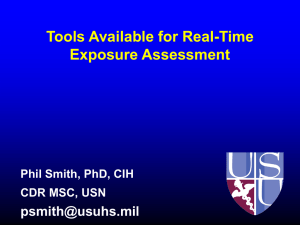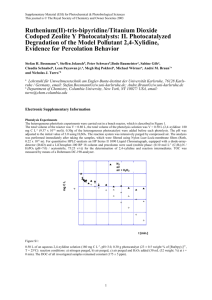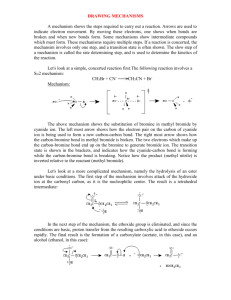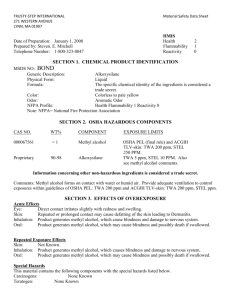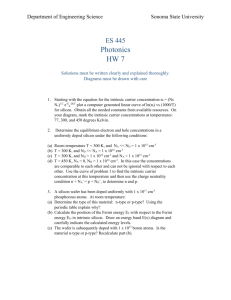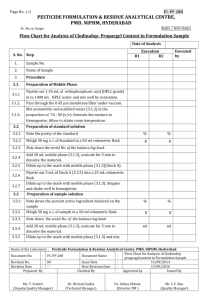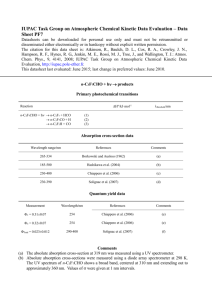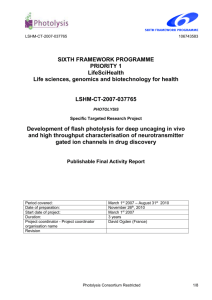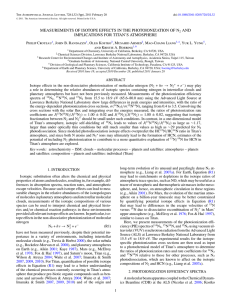Osborn_propargyl_xs_revised_SI
advertisement
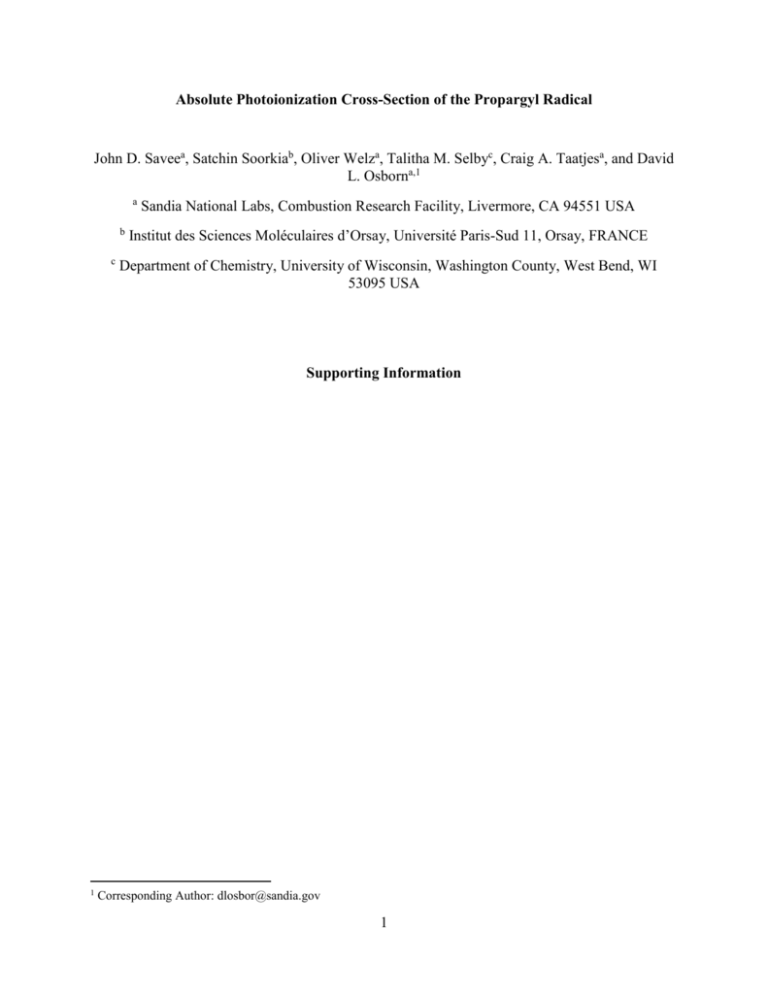
Absolute Photoionization Cross-Section of the Propargyl Radical John D. Saveea, Satchin Soorkiab, Oliver Welza, Talitha M. Selbyc, Craig A. Taatjesa, and David L. Osborna,1 a b c Sandia National Labs, Combustion Research Facility, Livermore, CA 94551 USA Institut des Sciences Moléculaires d’Orsay, Université Paris-Sud 11, Orsay, FRANCE Department of Chemistry, University of Wisconsin, Washington County, West Bend, WI 53095 USA Supporting Information 1 Corresponding Author: dlosbor@sandia.gov 1 1. Determination of Signal at the Time of Photolysis As discussed elsewhere,1,2 the finite propagation time occurring between the initial molecular-beam sampling of a photolytic product and its ultimate detection causes measured time profiles to be perturbed from ‘true’ kinetic profiles in the reactor. Part of the temporal instrument response function is induced by the velocity distribution of the sampled products emerging from the reactor tube. Prior to detection, sampled species encounter two distinct regions in the mass spectrometer where they can separate spatially according to their different velocities: neutral species first drift ~2.4 cm from the sampling orifice to the region where they interact with the ionizing radiation, and ions that are formed are then accelerated to ~10 eV kinetic energy and traverse ~13.2 cm to the center of the orthogonal extraction region. For these conditions, a simple model of the sampling process predicts average propagation times of 49.0 and 79.7 s for an initial 298 K Maxwell-Boltzmann distribution of methyl and propargyl radicals, respectively. Because the time constant for the decay of the radical population is substantially larger than the transit time, we can neglect the “blurring” of the time trace by the velocity spread,1,2 and simply offset the measured data by the average propagation delay to approximate the signal that would be measured inside the reactor. Kinetic decays for methyl and propargyl from 193 nm photolysis of 1-butyne were obtained at photoionization energies of 10.213 and 10.413 eV using a 1-butyne number density of ~ 1.8 × 1013 cm-3. A 0.94% depletion of 1-butyne was observed upon photolysis and, aside from methyl and propargyl, no other significant species arising from direct photolysis were observed. Assuming unity quantum yield for the CH3 + C3H3 product channel, the number densities for each of these species is estimated to be ~ 1.7 × 1011 cm-3 immediately following photolysis. The methyl and propargyl decays from 1,3-butadiene photolyzed at 193 nm were 2 obtained using a number density of ~ 2.4 × 1012 cm-3. Photolysis at 193 nm depleted the 1,3butadiene precursor by 45%. Using a CH3 + C3H3 branching fraction of 0.5,3,4 we estimate the initial number densities for methyl and propargyl produced by photolysis of 1,3-butadiene to be ~ 5.4 × 1011 cm-3. Dead-time effects in the OA-TOF detection system can cause an underestimation of the fractional depletion associated with parent species, which were typically run with high count rates.5 The number densities extracted for the photolytic products are thus lower bounds to the actual values, and the underestimation of number densities extracted from 1butyne depletion is expected to be more significant than that from 1,3-butadiene because 1butyne produced a much higher count rate (by an observed factor of ~5). References (1) S. B. Moore and R. W. Carr. Int. J. Mass Spectrom. Ion Process. 24, 161 (1977). (2) C. A. Taatjes. Int. J. Chem. Kinet. 39, 565 (2007). (3) J. C. Robinson, S. A. Harris, W. Z. Sun, N. E. Sveum, and D. M. Neumark. J. Am. Chem. Soc. 124, 10211 (2002). (4) H. Y. Lee, V. V. Kislov, S. H. Lin, A. M. Mebel, and D. M. Neumark. Chem.-Eur. J. 9, 726 (2003). (5) P. B. Coates. Rev. Sci. Instrum. 63, 2084 (1992). 3 Table S1. Absolute photoionization cross-section spectrum obtained for the methyl radical (m/z = 15) in the present work by scaling a relative measurement to absolute values as described in section 3.2 of the main text. Photoionization Energy (eV) 9.665 9.690 9.715 9.740 9.765 9.790 9.815 9.840 9.865 9.890 9.915 9.940 9.965 9.990 10.015 10.040 10.065 10.090 10.115 10.140 10.165 10.190 10.215 10.240 10.265 10.290 10.315 10.340 10.365 10.390 10.415 10.440 10.465 10.490 10.515 ion σmethyl (Mb) 0.01 0.03 0.00 0.05 0.13 0.21 0.68 3.51 3.80 4.54 4.31 4.20 4.80 4.79 4.76 4.66 4.79 4.74 4.98 4.93 5.36 5.41 5.43 5.46 5.84 6.22 5.76 5.61 6.10 5.92 6.11 5.87 6.00 5.71 5.95 4 Table S2. Absolute photoionization cross-section of propargyl (m/z = 39) obtained in the present work. A relative spectrum was scaled to absolute measurements as outlined in the text. Photoionization Energy (eV) 8.421 8.446 8.471 8.496 8.521 8.546 8.571 8.596 8.621 8.646 8.671 8.696 8.721 8.746 8.771 8.796 8.821 8.846 8.871 8.896 8.921 8.946 8.971 8.996 9.021 9.046 9.071 9.096 9.121 9.146 9.171 9.196 9.221 9.246 9.271 ion σpropargyl (Mb) 0.14 0.38 0.14 0.32 0.15 0.27 0.22 0.22 0.28 0.38 1.02 5.32 15.10 14.38 12.15 11.30 10.99 11.32 10.73 8.89 8.87 11.74 13.28 14.31 15.20 16.75 17.71 20.97 21.91 24.31 28.76 29.22 26.17 25.12 35.49 ion σpropargyl (Mb) 30.97 25.89 21.77 20.91 23.35 34.91 39.40 34.21 27.43 22.01 19.03 19.71 17.31 19.53 26.35 25.04 17.29 20.70 16.80 15.49 14.72 15.77 21.95 21.14 21.31 15.25 15.74 20.51 21.25 20.28 18.41 22.73 23.31 23.52 23.09 Photoionization Energy (eV) 9.296 9.321 9.346 9.371 9.396 9.421 9.446 9.471 9.496 9.521 9.546 9.571 9.596 9.621 9.646 9.671 9.696 9.721 9.746 9.771 9.796 9.821 9.846 9.871 9.896 9.921 9.946 9.971 9.996 10.021 10.046 10.071 10.096 10.121 10.146 5 Photoionization Energy (eV) 10.171 10.196 10.221 10.246 10.271 10.296 10.321 10.346 10.371 10.396 10.421 10.446 10.471 10.496 10.521 10.546 ion σpropargyl (Mb) 22.49 26.59 23.82 24.02 23.29 20.79 22.96 22.94 24.88 24.17 24.12 21.41 21.73 26.21 26.73 26.97

